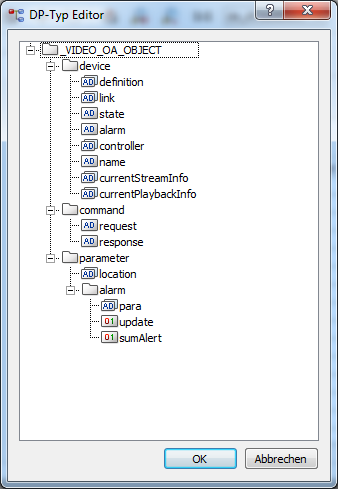|
Real video objects only consist of the video basic type
_VIDEO_OA_OBJECT. This real objects can be extended and changed
project-specific except for the structure element object. You
can also create new real objects by inserting a type reference of
the VIDEO_OA_OBJECT type with the element name object to the
new type.
Naming concept of video objects
The naming concept of video objects corresponds the following
pattern:
VIDEO_OA_CAMERA Camera_<Nr. %05d> e.g. Camera_00001
VIDEO_OA_CONTROL_INTERFACE Control_Interface_<Nr. %05d> e.g.
Control_Interface_00001
VIDEO_OA_ENCODER Encoder_<Nr. %05d> e.g. Encoder_00001
VIDEO_OA_WORKSTATION Workstation_<Nr. %05d> e.g. Workstation
_00001
For the following video objects you can assign names at will:
VIDEO_OA_DISPLAY
VIDEO_OA_ENCODER_POOL_CHANNEL
VIDEO_OA_FTP_ALARM_RECEIVER
VIDEO_OA_HOST
VIDEO_OA_RECORDING_SESSION
VIDEO_OA_RTSP_SERVER
VIDEO_OA_SERIAL_DEVICE
VIDEO_OA_STREAMING_PROXY
Structure of video objects
A video object is constructed in the following way:

| Element |
Type |
Description |
| device |
Structure |
All device specific definitions as well as
the device state are specified under the data
point structure element device. |
| device.definition |
dyn_string |
The definition element defines the device type
and device specific properties.
[1] Device type and properties
[2-…] Reserve
|
| device.link |
dyn_string |
The link element contains all configuration
parameters that the video sub system needs for the
configuration of the appropriate video object. All
link information is interpreted by the video
manager and is synchronized to the vimacc
database.
[1] Configuration for RC0 (Normal mode)
[2] Configuration for RC1 (Server 2 is
down)
[2] Configuration for RC2 (Server 1 is
down)
|
| device.state |
string |
This element contains information about the
current state of the video object. The single
parts of the information are stored as pairs,
consisting of keyword and value. |
| device.alarm |
string |
External device events as character string,
e.g. MOTION_ALARM=1. The string is overwritten by
the next change. |
| device.currentStreamInfo (only used for
VIDEO_OA_CAMERA) |
string |
This element contains all information which
must be passed to the display-widget in order to
display a live stream.
stream_1=… Information for stream 1
stream_2=… Information for stream 2
stream_3=… Information for stream 3
e.g.:
stream_1=Camera_0001@CCTV-SRV1:9375);
stream_2=Camera_0001__2@CCTV-SRV1:9375);
There is an additional entry for each active
streaming proxy instance:
stream_1.<Proxy dp>=...
|
| device.currentPlaybackInfo (wird nur bei
VIDEO_OA_CAMERA verwendet) |
string |
This element contains all information that must
be passed to the display-widget in order to
display a playback stream. .
stream_1=… Information for stream 1
stream_2=… Information for stream 2
stream_3=… Information for stream 3
e.g.:
stream_1=Camera_0001@CCTV-SRV1:9375);
stream_2=Camera_0001__2@CCTV-SRV1:9375);
Currently not in use.
|
| device.controller |
dyn_string |
Specifies which host (VIDEO_OA_HOST) manages a
video object in the different operating modes.
[1] Host for RC0 (Normal mode)
[2] Host for RC1 (Server 2 is down)
[2] Host for RC2 (Server 1 is down)
|
| device.name |
string |
In this element the display name is passed to
the video management system. This name is shown
when a camera is opened on a display
server. |
| command |
Structure |
The command interface is defined under this
structure element. |
| command.request |
string |
The commands are sent to the device via this
element. |
| command.response |
string |
This element asynchronously signalizes
responses of the executed commands. The answers of
the device are written on the response element.
Generally the answer contains the command string
of the request element at first. Then the answer
is appended. Thereby the user can transmit own
user data to the command interface. |
| parameter |
Structure |
Miscellaneous configurations are defined
under this structure element. |
| parameter.location |
dyn_string |
Configuration for the display of CNS trees.
Currently not in use.
|
| parameter.alarm |
Structure |
Configurations for the analysis of a video
object's alert are defined under this structure
element. |
| parameter.alarm.para |
dyn_string |
The assignment of keywords of external device
events to data point elements are stored on this
element. Each row contains an assignment in the
following pattern:
<keyword>|<Data point element>
e.g.
MOTION_ALARM|Kameraalarm01.alarm
|
| parameter.alarm.update |
bool |
A dpSet with the value 1 on this element
triggers an update of the data point elements
(with the value of devie.alarm) assigned to the
keywords. The update is automatically executed in
case of a change of device.alarm. If a new keyword
which is contained in device.alarm is configured,
the value of the assigned data point element can
be updated without changing device.alarm. |
| parameter.alarm.sumAlert |
bool |
Currently not in use. |
Details and keywords of the single elements
The data point elements definition, link, state,
request, response of type string or dyn_string are
set with variable assignments in the form of character strings. The
character strings are sequences of variable assignments that are
separated by semicolons. A variable assignment chain has the
following general structure:
<Designator>=<Value>;<Designator>=<Value>;...;<Designator>=<Value>
See the following chapters for a detailed description of:
|




